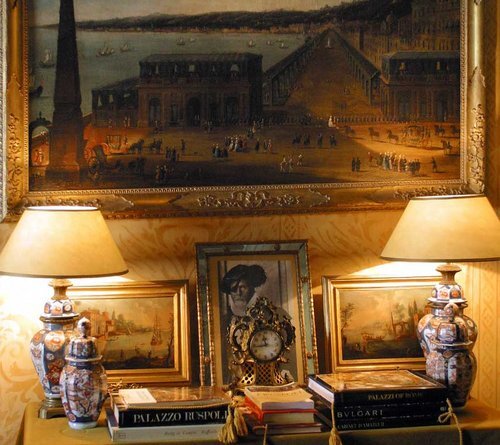Haute hôtellerie in Rome, Italy
Palazzo Ruspoli
Residenza Napoleone III - Palazzo Ruspoli, Rome.
I have always wondered how modern technology, and I mean optic-acoustic systems specifically, is incorporated into the heavily-decorated palaces that are brimming over with Roman baroque. At a dinner party one night, sitting on brocade chairs around a beautiful table, I found myself wondering where they could be hidden, and one day I made my discovery. It was one evening when I visited an American friend who would be in Rome for only a few days and was staying at the palazzo Ruspoli.
“Has it been converted into a hotel?” I asked on the phone.
“No, but the princess decided to rent out the official guest rooms to visitors who come to the city but don’t want to stay in a traditional hotel,” she answered.
Residenza Napoleone III - Palazzo Ruspoli, Rome.
This is the new trend in haute hôtellerie. It began in Europe a few years ago and found substantial ground in Rome, the baroque, snobbish and eccentric, and which is always looking for something new to present. In other words, this kind of hospitality contains the very essence of eclectic elegance, which is difficult to find even in the best hotels. It is like haute couture, everything is cut and fit according to the tastes of a specific clientèle, who I am not altogether sure is in a position to really appreciate it, but can definitely afford the astronomical prices.
“Let’s see what’ s happening with Obama,” my friend said, as we were sitting in the living room, taking our tea. It was the final round for the leadership of the Democratic party in the U.S. and, as she said this, she got up and took hold of the corner of a painting opposite us. It was by a Flemish artist of the 18th century, and as she pulled on it as if she were opening a closet door, behind it appeared a built-in, state-of-the-art plasma TV. We watched the news and then, because I had to leave, my friend suggested I freshen up in her bathroom.
“Thank you,” I told her, and asked her where it was.
“Go to the bedroom and to the left you will see a Capriccio. Pull on the corner and go inside,” she explained.
Residenza Napoleone III - Palazzo Ruspoli, Rome.
Capriccio in Italian painting means a landscape to which the artist adds a deserted monument which comes to him at that particular moment, and that is where the name is derived from. For example, Canaletto painted lovely Caprices and, fortunately, the one I opened, in the semblance of a door, was not one of his. Of course the bathroom, literally a hole in the wall, was outfitted in a very luxurious manner, with marbles and mirrors and the delicate scent of gardenia.
Leaving, I saw the maid walking past holding a tray and, pulling on another Capriccio. A tiny kitchenette with the most modern appliances made its appearance, all shiny and brand new. An espresso maker, porcelain cups and saucers and a silver coffee pot were all there.
In this little jewel of an apartment, I fell upon one surprise after another, each designed to make the best use of the space at hand and, as everything was authentic, I left quite charmed.
My long sojourn in Rome is described in the book: Feeling Rome



